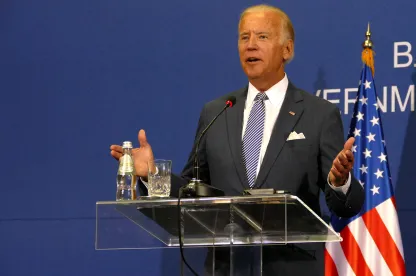President elect Joe Biden has set forth two comprehensive plans targeting clean energy and climate change (collectively “The Biden Energy Plan”).[1] The Biden Energy Plan seeks to aggressively pursue a net-zero (carbon neutral) power sector by 2035 and a net-zero U.S. economy by 2050. Additionally, themes from Biden’s Build Back Better plan for job growth and economic recovery are interwoven throughout the Biden Energy Plan.
The Biden Energy Plan is comprised of the following major initiatives:
Biden Energy Plan Commitments for Day 1 of the Biden Administration
On Day 1 of Biden’s administration, Biden plans to put the Biden Energy Plan into action by requiring methane pollution limits for new and existing oil and gas operations, developing new fuel economy standards, aiming for 100% of sales for light- and medium-duty vehicles to be zero emissions, and protecting federal lands and waters from new oil and gas leasing.
Clean Energy Mobilization at the Federal Level
To reach net-zero by 2050, Biden plans to invest $1.7 trillion federal funds over the next 10 years leading to private, state and local investments of $5 trillion, in clean energy research and modernization. The Biden Energy Plan will leverage the Federal government procurement system to help achieve its objectives. Under that program, which calls for the spending of $500 billion every year, Biden will pursue increased deployment of zero-emissions vehicles for federal, state, tribal, postal, and local vehicle fleets.
The Biden Energy Plan will push for all U.S. government installations, buildings, and facilities to use clean energy technology to decrease emissions and run more efficiently. All Federal infrastructure investment will aim to reduce climate pollution. Permitting processes will include a requirement to consider the effects of greenhouse gas emissions and climate change prior to issuance of the permit. In addition, the Biden Energy Plan will enhance reforestation and responsible deployment of renewables on Federal lands and waters, with the goal of doubling offshore wind installations by 2030.
President-Elect Biden plans to create a new Federal agency to develop advanced technologies and assist with research and implementation. The new agency, titled Advanced Research Projects Agency (ARPA-C), will be focused on technologies needed to achieve a clean energy target. Examples of those technologies include:
-
grid-scale storage at one-tenth the cost of lithium-ion batteries;
-
small modular nuclear reactors at half the construction costs of today’s reactors;
-
zero net energy buildings at zero net cost;
-
use renewables to produce carbon-free hydrogen at the same cost as that from shale gas; and
-
capture, sequester, or repurpose carbon dioxide from power plant exhausts; and enhance tax incentives for carbon capture, use and storage.
The new, cross-agency ARPA-C will also be charged with supporting a research agenda to examine ongoing challenges facing nuclear power, such as cost, safety and waste disposal issues.
Private Sector Disclosures and Industry Reform
The Biden Energy Plan pledges to issue requirements for private companies to publicly disclose climate risks and greenhouse gas emissions in their operation and supply chains in an effort to increase transparency. The Biden Energy Plan also focuses on holding polluters accountable and includes a requirement to establish by 2025 an enforcement mechanism that will require polluters to bear the cost of their carbon pollution.
With respect to buildings and urban planning, the Biden Energy Plan seeks to create incentives and enact aggressive appliance and building efficiency standards to reduce the carbon footprint of Federal and private sector buildings by 50% by 2035 and address the effects of urban sprawl by proposing to amend local regulations to allow for denser, more affordable housing near public transit.
Additionally, the Biden Energy Plan sets forth a list of recommendations and reforms which will be required for various sectors of industry, including transportation, manufacturing, agricultural, and airlines.
For the transportation industry, the Biden Energy Plan sets forth the following initiatives:
-
Establish new fuel economy standards to ensure that 100% of new sales for light and medium duty vehicles will be electrified.
-
Deploy more than 500,000 new public charging stations by the end of 2030.
-
Restore the full electric vehicle tax credit from $3,750 to $7,500 to incentivize the purchase of those vehicles, with priority given to the purchase of American-made brands.
-
Create technology standards for aircraft developed to reduce emissions.
-
Incentivize development of new sustainable fuels to support technology standards by reducing emissions.
President Elect Biden plans to utilize tax credits and subsidies to develop a low-carbon manufacturing sector in every state. The Biden Energy Plan seeks to reform the agricultural sector by incentivizing farmers and ranchers to invest in climate-friendly farming by deploying the latest technology to minimize environmental impacts. Additionally, President Elect Biden plans to create new opportunities to support the deployment of methane digesters to capture emissions, generate electricity and receive revenue.
[1] The “Biden Energy Plan” is comprised of The Biden Plan to Build a Modern, Sustainable Infrastructure and an Equitable Clean Energy Future and The Biden Plan for a Clean Energy Revolution and Environmental Justice.





 />i
/>i
